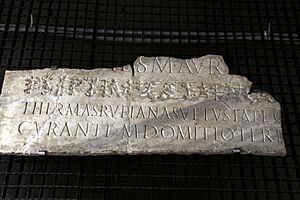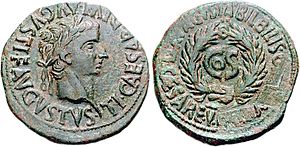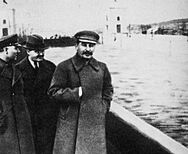Damnatio memoriae facts for kids
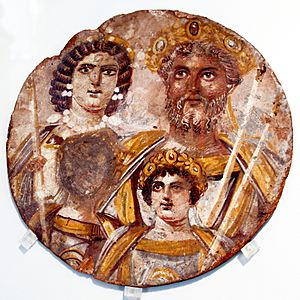
Have you ever heard of someone being "erased from history"? This practice has a special name: Damnatio memoriae. It's a Latin phrase that means "condemnation of memory." When a powerful person, like a king or emperor, fell out of favor, the new rulers would try to wipe them from all official records.
This meant destroying their statues, scratching their names off buildings and documents, and sometimes even rewriting history books to pretend they never existed. It was the ultimate punishment, meant to make sure no one would remember them.
Interestingly, the ancient Romans never used the exact phrase damnatio memoriae. The term was first used in Germany in 1689, long after the Roman Empire had fallen.
Contents
Erasing People in the Ancient World
The idea of erasing someone from memory is very old. It happened in many ancient civilizations long before the Romans.
Ancient Egypt
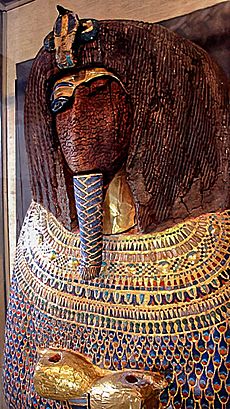
In Ancient Egypt, pharaohs were seen as gods. But some pharaohs were so disliked that later rulers tried to erase them.
One famous example is the pharaoh Akhenaten. He changed Egypt's religion, telling people to worship only one god, Aten, instead of the many gods they had always known. This was a huge change, and many people were unhappy.
After Akhenaten died, the old religion was brought back. Temples built for Aten were torn down, and the stones were used for other buildings. Statues of Akhenaten had their faces smashed, and his name was removed from records. Even the famous boy-king Tutankhamun was briefly erased from some lists because he was connected to Akhenaten's family.
Another pharaoh, Hatshepsut, one of the few women to rule Egypt, also had many of her statues and monuments destroyed by the pharaoh who came after her.
Ancient Greece
The ancient Greeks also practiced this. In the city of Ephesus, a man named Herostratus burned down the beautiful Temple of Artemis, one of the Seven Wonders of the Ancient World. He did this just to become famous. As a punishment, the leaders of Ephesus made it illegal for anyone to ever say his name again.
In Athens, when politicians or generals became unpopular, their names were sometimes chiselled off public records. After the Macedonian king Philip V of Macedon attacked their city in 200 BC, the Athenians destroyed all monuments and inscriptions that honored his family.
Ancient Rome
The Romans are the most famous for practicing damnatio memoriae. When an emperor died, the Roman Senate could decide to officially condemn his memory. If this happened, his statues would be torn down or have their faces re-carved. His name would be erased from public buildings, and his laws could be cancelled.
However, completely erasing someone was almost impossible. Imagine trying to find every single coin with an emperor's face on it! For example, after Emperor Geta was killed by his brother Caracalla, it was a crime punishable by death to even say his name. But coins with his face on them were still found for years.
Because of this, some historians think the goal wasn't to make people forget. Instead, it was to turn a monument of honor into a public insult. When people saw a statue with a missing head or a name scratched out of an inscription, they would know that person had been disgraced.
Roman Rulers Who Were Condemned
Many Roman emperors and powerful figures faced damnatio memoriae. Here are a few well-known examples:
- Caligula (Ruled 37–41 AD)
- Nero (Ruled 54–68 AD)
- Domitian (Ruled 81–96 AD)
- Commodus (Ruled 177–192 AD)
- Geta (Ruled 209–211 AD)
Erasing History After Ancient Times
The Middle Ages
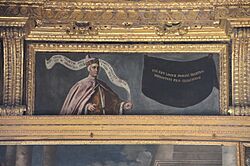
The practice continued into the Middle Ages. Church leaders sometimes condemned the memory of people they considered heretics (those who went against official church teachings). For example, the memory of the religious reformer John Wycliffe was condemned by the Council of Constance.
In Venice, Italy, the leader Marino Faliero tried to overthrow the government in 1355. He was caught and executed. In the great hall where portraits of all the leaders of Venice were hung, his portrait was removed. In its place, a black cloth was painted with the words: "This is the space for Marino Faliero, beheaded for his crimes."
The Americas
In the ancient Maya civilization, rulers would sometimes erase the records of their rivals. In the kingdom of Paʼ Chan (in modern-day Mexico), a king named Yaxun Bʼalam IV may have destroyed all records of the ruler who came before him to make his own claim to the throne seem stronger.
Later, after the Spanish arrived in the Americas, they also destroyed monuments. In the 16th century, a Spanish bishop ordered the destruction of a portrait of Nezahualcoyotl, a famous king of Texcoco, so that he would "no longer be remembered."
Modern Examples of Erasing the Past
Even in the last 100 years, governments have tried to erase people from history. This became much easier with photography.
In the Soviet Union, the government was famous for airbrushing people out of photographs. When a political leader like Leon Trotsky or Nikolay Yezhov fell out of favor with the dictator Joseph Stalin, they would disappear from official photos as if they were never there. After the fall of communism in Eastern Europe, many countries tore down statues of communist leaders like Lenin and Stalin.
This practice has happened in other countries too:
- In China, the politician Zhao Ziyang was removed from public life and official records after he showed support for student protesters in 1989.
- In North Korea, when the powerful uncle of leader Kim Jong-un, Jang Song-thaek, was executed in 2013, he was quickly removed from all official news reports and photos.
These modern examples show that the desire to control memory and history is still a powerful force in the world today.
See also
 In Spanish: Damnatio memoriae para niños
In Spanish: Damnatio memoriae para niños
- Cancel culture
- Censorship of images in the Soviet Union
- Denazification
- De-Stalinization
- Historical negationism
- Iconoclasm
- Memory hole
- Nineteen Eighty-Four, a famous novel where the government constantly rewrites history
- Persona non grata
- Shunning


